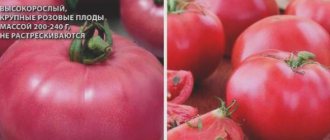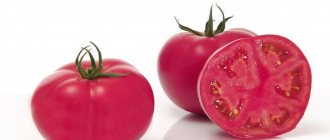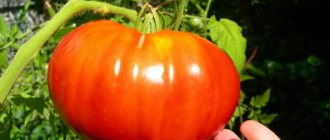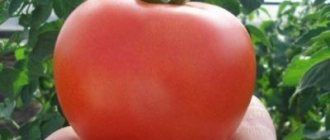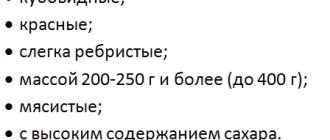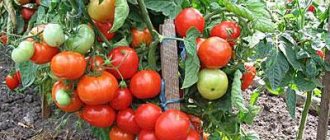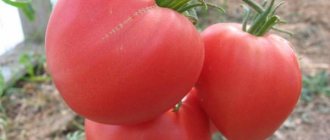Tomato Pink Solution F1 is a Dutch hybrid, and like all tomatoes created there, it has excellent taste, immunity to disease and good yield. The fruits have a beautiful presentation.
| Height | Landing location | Ripening time | Fruit color | Fruit size | Origin | Fruit shape |
| Tall | Greenhouse | Mid-early | Pink | Large | Hybrid | Heart-shaped |
Detailed description of the plant
Tomato Pink Solution F1 is a hybrid of Dutch selection, indeterminate in growth type, therefore, like all plants of this group, it has a bush height above 1.5 m. In terms of fruit ripening, the hybrid is included in the group of mid-early tomatoes; the fruits begin to ripen 70 days after the appearance of the first shoots.
The description of the variety given by the manufacturer guarantees the declared yield and other characteristics only when the tomato is grown in a greenhouse. Plants of this variety grown outdoors may not conform to this description. According to the manufacturer’s recommendation, the bushes need to be tied to a strong support, pinched, and the bushes formed into one stem.
The hybrid is resistant to a number of tomato diseases (fusarium, TMV) and adapts well to stressful conditions. The plant produces heart-shaped fruits with slight ribbing in the stalk area, uniform in shape and size.
Large fruits weigh 250 g, the average fruit weight for the entire growing season is 200 g. The fruit cluster can consist of 3 or 5 fruits. The color of the skin and pulp of the fruit is pink. The pulp is juicy, fleshy, aromatic, and corresponds to its salad purpose. The taste of the fruit is seasoned, harmonious, ideal for light vitamin salads.
Characteristics of tomato Red Krasno F1
Also check out these articles
- Pepper variety Ratunda
- Cow pregnancy
- Planting grape seedlings in spring
- How and what to feed ducklings from birth
Below are the characteristics of the hybrid Red Red F1.
- The hybrid is early, early ripening.
- Quick adaptation to different weather conditions (heat, coolness, rainfall).
- Productivity is high and stable, regardless of the weather.
The highest productivity is observed in greenhouses or greenhouses - 18-20 kg/m2. When grown in open ground, the yield will be 10-11 kg/m2. The highest yields are observed in greenhouses or greenhouses - Bushes are immune to many diseases.
- The keeping quality of the crop is high, transportability is acceptable.
- Tomato Red Red F1 has a marketable appearance. The fruits are bright, regular in shape with a rich aroma.
As for the disadvantages characteristic of the Red Red F1 hybrid, it is the need to grow in fertile soil. If the soil is not fertilized, the tomatoes may not germinate, produce low yields, or the taste may suffer. So before planting seedlings or sowing seeds, it is necessary to regulate the acidity of the soil and apply fertilizers.
Gardeners' opinion
It is quite difficult to find extensive reviews about the Pink Solution tomato on the Internet. For the most part, summer residents limit themselves to characterizing the taste of the fruits of this hybrid. Their opinions can hardly be called unambiguous. For some the taste is excellent, for others it is sour. Apparently, to find out the truth, you need to plant Pink Solution yourself and evaluate all its advantages and disadvantages.
See also
Characteristics and description of the Rome tomato variety, its yieldRead
Alina, Volgograd
I love experimenting with varieties; every year I try up to ten new hybrids and varieties. I don’t forget the Dutch selection; today I planted several bushes of the Pink Solution hybrid. Usually the Dutch were grown for spinning, but these were eaten in salads. They sang early, in harmony, the taste is quite suitable for summer salads. I recommend this hybrid to lovers of pink tomatoes.
Tatiana, Kemerovo
I tried Pink Solution and planted several bushes. I did not enjoy the taste. Although the hybrid is productive, I will not plant it anymore. I love sweeter pink tomatoes, but these seemed a little sour to me.
Features of the Pink Paradise tomato variety
Hello, dear readers! The variety, the description of which I want to present to you, received the highest rating from the audience at one of the seminars held in 2011 and was recognized as one of the best varieties of pink tomatoes. We are talking about the Pink Paradise tomato.
Fruit characteristics
Tomato Pink is the result of selection by Japanese specialists who worked to create a variety with excellent taste and quality characteristics. Appearing relatively recently - in 2009, the Pink tomato managed to gain popularity among our compatriots.
Ask and receive useful advice from professional gardeners and experienced summer residents.>>
And if just recently this overseas hybrid was quite difficult to get, today f1 tomato seeds are not a problem to buy. The tomato variety called Pink Paradise is mid-season and high-yielding. If you follow the growing technology, you can get 4 kg of very tasty, one-to-one beautiful pink tomatoes from one bush.
Their average weight varies between 120–140 g, although it can reach 200 g. Usually fruits of the same size are concentrated on one branch. The peculiarity of this hybrid is the average density of the fruits, but having a fairly delicate skin, they are not prone to cracking and tolerate storage and transportation well.
At the same time, the plants themselves, belonging to the indeterminate type, can grow 2 m in height, and therefore require obligatory tying to a support and formation into one or two stems. This pink tomato is distinguished by its large foliage. The castings reach a medium size, but there are quite a lot of them. The inflorescences are simple, forming at least 4 nests.
Advantages and disadvantages
The advantages and disadvantages of the tomato variety are as follows:
- Excellent fruit set even in hot weather.
- Resistance to small temperature changes.
- Excellent presentation.
- Increased resistance to pests and diseases.
- Good harvest.
- High sugar content.
- Among the shortcomings, only those that are characteristic of all hybrids can be identified. First of all, they relate to compliance with agricultural technology. Tomatoes are recommended for cultivation in a greenhouse or greenhouse, where the necessary growing conditions can be maintained. There is no point in collecting seeds, because it is impossible to obtain specimens with the same characteristics from them.
Features of cultivation
The conditions for growing this variety of tomatoes are no different from the rules for cultivating other varieties of these vegetables, although there are definitely certain nuances here.
Experts advise sowing seeds for seedlings 60–65 days before transferring them to a prepared and specially designated area in the garden. Before placing them in special peat pots, they should be kept in a growth stimulator, and then deepened into a mixture of turf or garden soil with humus. Having moistened the plantings and covered them with film, you can wait for the first shoots to appear.
Recommendations for care are as follows: maintain the air temperature at + 23–25 °C, ensure sufficient light, and as for watering, it is better to spray the seedlings with a spray bottle.
As soon as the first pair of leaves appears, Pink Paradise f1 tomatoes can be planted in separate pots, not forgetting to feed them with complex fertilizer. Hardened seedlings can be transferred to an open bed in mid-May, when the weather has calmed down and the soil has completely warmed up.
However, having decided to grow the f1 hybrid outside the greenhouse, it is necessary to care for the plants more carefully, trying to provide conditions as close as possible to greenhouse conditions. When planting, leave a distance of at least 60 cm between the bushes and it is better to immediately tie the young seedlings to a support.
A week after transplanting, it is recommended to feed the bushes. The first fertilizer for tomatoes should be nitrogen, and when the fruits form, it is better to replace it with potassium-phosphorus. Succinic acid will help increase tomato yields, although gardeners often use other stimulants.
Judging by the reviews and photos of tomato bushes grown in a greenhouse, gardeners do not neglect the procedure of tapping or moving the bushes during flowering, which improves their pollination and increases the chances of a good harvest. Tomatoes called Pink Paradise do not cause gardeners any particular problems with diseases.
They rarely suffer from verticillium and fusarium wilt, cladosporiosis, brown spot, root nematode, but in any case it is necessary to carry out prevention from time to time, although multiple treatments can be avoided with good care.
Recommendations for sowing seeds for seedlings
The standard time for sowing seeds for seedlings is early to mid-March; it can be shifted in one direction or another. The specific period depends on the time of transplanting the plants into the greenhouse. Tomato seeds, before sowing in the ground, should be soaked in a stimulant solution.
Prepare the soil from equal parts of humus and garden soil; if the soil in the garden is clayey (heavy), add a small amount of sand. The seeds are sown in boxes, covered with a layer of earth up to 2 cm thick, the boxes are covered with film, which is removed only after the sprouts have pecked.
Pick seedlings (2-leaf phase) into separate containers with a volume of 350-500 ml. Before transplanting into the greenhouse, feed the seedlings with any complex fertilizer for tomatoes. Regularly monitor soil moisture and water with settled water if necessary.
Tips for growing rose hybrids
For good development of the Dutch rose-fruited hybrid, well-fertilized, moist soil is suitable. Here are a few rules, following which, you can grow a good harvest of beautiful pink fruits:
- do not thicken the plantings, the distance between the bushes is 50 cm or more;
- To obtain a good taste of pink fruits, apply abundant watering and fertilizing evenly;
- Feeding is especially important after planting tomatoes in a permanent place, at the beginning of flowering, at the initial stage of ovary formation;
- do not overwater your tomato plantings if the soil has been allowed to dry out or the drought has been prolonged: restore soil moisture gradually, this will help avoid cracking of the fruits;
- the hybrid needs light to develop, plant it in non-shaded areas;
- bushes need to be tied up regularly;
- keep the bushes in good shape - remove stepsons;
- loosening the rows is a mandatory procedure after each watering;
- do not abandon preventive measures that protect against late blight and blossom end rot; pink tomatoes are less resistant to fungal infection than varieties (hybrids) with red fruit;
- For better fruit ripening, you can normalize the number of brushes, leaving no more than 8 pieces.
See also
Recommendations for gardeners for 2021 according to the lunar sowing calendarRead
Description and characteristics of the tomato variety Amber bunch f1
Every summer resident is looking for a variety of tomatoes that would please them with early ripening, taste, and ease of care. The amber bunch tomato can boast of such versatility.
Characteristics of the variety
This is an unpretentious, cold-resistant tomato that can be grown both in film shelters and in open ground. Able to create an ovary even at low temperatures. Tomato Amber bunch is formed into a standard bush of a round shape. The height of the stem is only 40 - 50 cm. The small size inherent in the hybrid allows you to plant 2 times more plants in the same area than conventional varieties of tomatoes.
The leaves are medium-sized, dark green, traditional in shape for members of the nightshade family. The tomato does not require pinching of the apical bud, since it is a determinate hybrid, that is, it has limited growth. No pinning required. The plant itself forms only 1 – 2 stems. Inflorescences begin to form after 5–6 leaves. Strong stalks prevent the fruits from falling off.
This is an early ripening variety, the period from the first shoots to harvest reaches from 85 to 105 days. It all depends on weather conditions if tomatoes are grown in open ground, and on temperature conditions if they are planted in a greenhouse.
Description of fruits
A rounded and slightly plum-shaped shape, a flat and smooth surface, a weight of 50 to 70 grams and a yield of 2.5 kg per bush are decent characteristics for an early ripening variety. Ripe tomatoes are uniform in size, have a rich amber-yellow color and a dense consistency. They are great for both fresh consumption and for canning whole fruits. Miniature tomatoes will decorate a vegetable salad, any meat and even fish dish, and when prepared they look presentable and do not crack. Tomatoes of this variety have a pleasant taste and sweet aroma.
Due to its unpretentiousness, it will not be difficult for an experienced summer resident to grow the Amber Bunch F1 tomato, and the description of the rules for caring for it is quite standard.
Landing
Sowing of seeds should be carried out in March, or 50 days before planting in a permanent place. Seedlings should be picked after they produce their first true leaves. If there is heating in the greenhouse, seedlings can be planted in it in April. If planted in open ground under a film cover, you must wait until mid-May. A distance of 40 cm should be left between plants, and 70 cm between rows.
Hilling
The root system of the Amber Bunch tomatoes is located shallow in the ground, as a result of which it requires infrequent, but abundant watering. To ensure air access to the roots, the soil should be loosened and the plants should be hilled. This will further strengthen the root system and protect it from drying out.
At the beginning of flowering, small tubercles can be seen on the basal section of the stem. These are the beginnings of adventitious roots that will develop and additionally supply the plant with nutrients. The first hilling should be carried out during this period, and subsequently repeated 2 - 3 times.
Top dressing
In order to ensure the formation of a strong bush and increase productivity, it is good to fertilize these plants approximately once every three weeks. In the first time after planting, you need to give them the opportunity to overcome stress and get used to the new place, and after the formation of the first flower cluster, apply fertilizer for the first time. Typically this period corresponds to the third week after disembarkation.
The Amber Bunch tomato is not picky in choosing options for feeding. This could be a solution of chicken manure with superphosphate, mullein, ordinary ash, or fermented grass.
The hybrid boasts resistance to disease, but for preventive purposes, periodic spraying with special agents can be carried out. Simple hilling will prevent pests from penetrating tomato stems.
Prevention of diseases and their treatment
Preventive measures in the greenhouse are necessary, despite the resistance of Dutch hybrids to a number of diseases. By maintaining a normal level of air humidity in the greenhouse, most diseases of fungal origin can be avoided.
To do this, the greenhouse must be equipped with convenient windows for ventilation. It is easy to avoid condensation on the walls of the greenhouse at night and in the morning. You should avoid evening watering and water only early in the morning. Mulch on beds of hay and straw reduces air humidity, but retains moisture in the soil and serves as good protection against late blight. Treat the plants with a fungicide (Fitosporin) if it was not possible to avoid infection with the fungus.
A high-yielding hybrid with pink fruits, with proper care it will perform well and will become a regular in your tomato collection. There is no need to lag behind summer residents who successfully grow Dutch hybrids in their greenhouses.
Planting tomatoes in open ground
"Pink Paradise" is a hybrid plant variety, which means it is not advisable to grow it in open ground. This approach can easily lead to disastrous consequences: tomatoes may not show the properties that are indicated in the characteristics of the plant.
Those who decide to grow outside a greenhouse are advised to carefully care for the plant. We must try to create conditions as close as possible to greenhouse conditions.
If possible, cover the seedlings with film material, which will create a greenhouse effect in open ground.
In this case, you need to pay attention to the fact that the shoots will rise higher each time, and the film (or other material) will need to be raised just as high
In open ground in July, treat the soil with a systemic fungicide against late blight. Wait for rainy weather to perform this procedure. After 2 weeks, repeat the process again.
If the summer turns out to be too rainy and precipitation falls very often, treat with a fungicide every 2 weeks. Stop this process 14 days before harvest.

